Even when they’re performing at SeaWorld, the name killer whale is difficult to shake off. Orcas have an apex predator diet of seals, penguins, baby whales, sea lions, and dolphins that they hunt in family groups called pods. Orcas have stealthy hunting techniques and are some of the fastest marine mammals.
Orca are universally recognized for their unique dorsal fin, black-and-white pattern, and memorable performances. Marine biologists are getting acquainted with their superior intelligence and communication skills.
However, there were also fatal incidents.
10 Amazing Facts About Orcas
- Orcas are the largest member of dolphin family
- The length of orcas usually falls within the range of 5.5 to 9.8 meters
- Orcas can have a maximum weight of 5,500 kilograms
- Orcas identify their prey via echolatin
- Orcas prey upon fish, seals, seabirds, and marine turtles
- Orcas are incredibly swift swimmers, reaching speeds of up to 54 kph
- Orcas can have a non stop traveling of up to 9,400km
- Orcas are among the few mammals that experience menopause
- The gestation period of orcas is 17 months
- The lifespan of orcas is around 50 – 90 years
Scientific Classification of Orcas
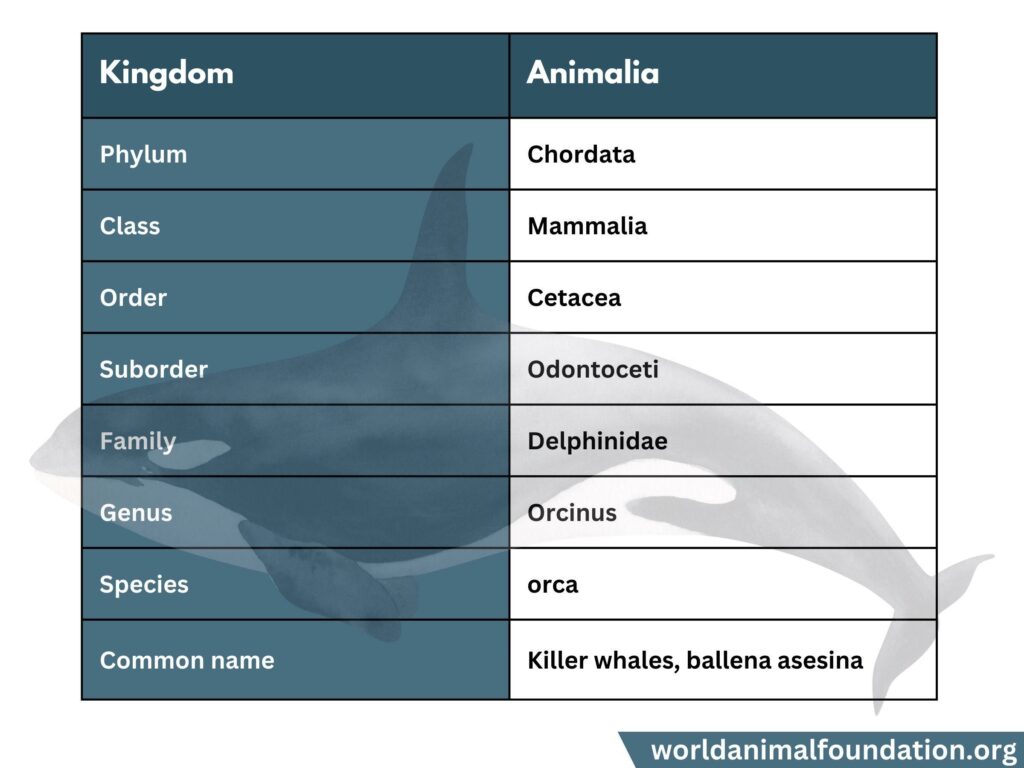
Orca Facts
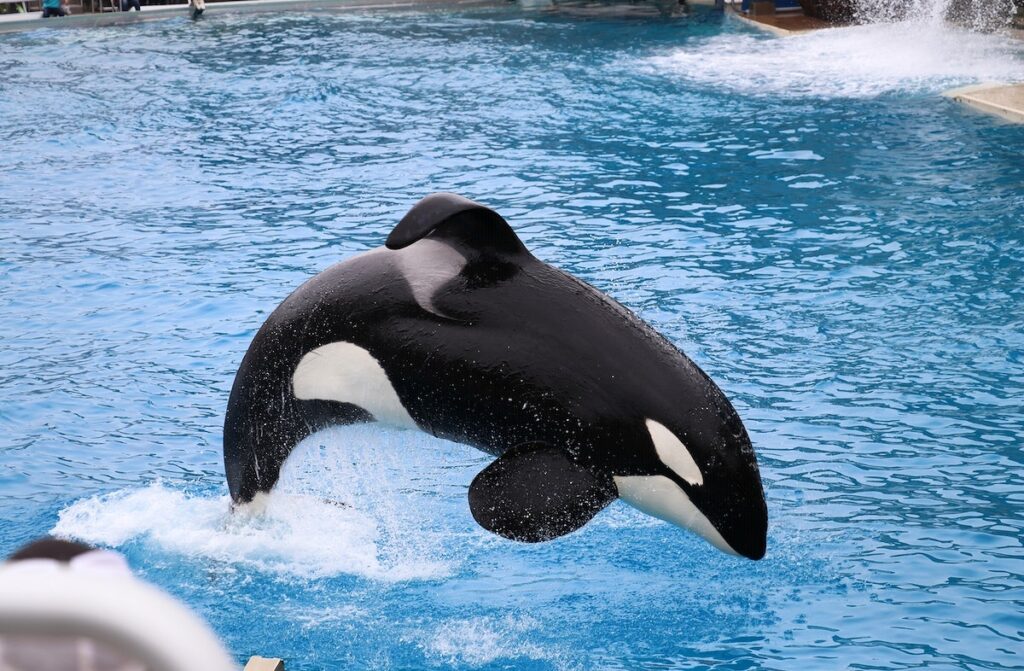
Orcas are intelligent creatures and form social interactions within their pods.
Orcas Are Found Worldwide, Making Them One of the Most Widely Distributed Mammals Across Oceans (NWF.org)
Distinct groups of orca make their home across seven oceans. Orcinus orca are classified into transient, resident, and offshore types, have genetic differences, and don’t interbreed. (source)
Orcas Are the Largest Member of the Dolphin Family (Ocean Conservancy)
Orcas are a fascinating dolphin species. Although small compared to their whale cousins, which can grow to over 100 feet, orcas can reach 32 feet. (source)
Orcas Are Distinguished by Their Unique Dorsal Fins and Saddle Patches (SeaWorld)
We identify Orcinus orca with their distinct black and white saddle and cape pattern, their famous toothy smile, and their highly visible and recognizable dorsal fin. (source)
Orcas Possess Around 40–56 Sharp Teeth That They Use for Capturing Their Prey (NOAA.gov)
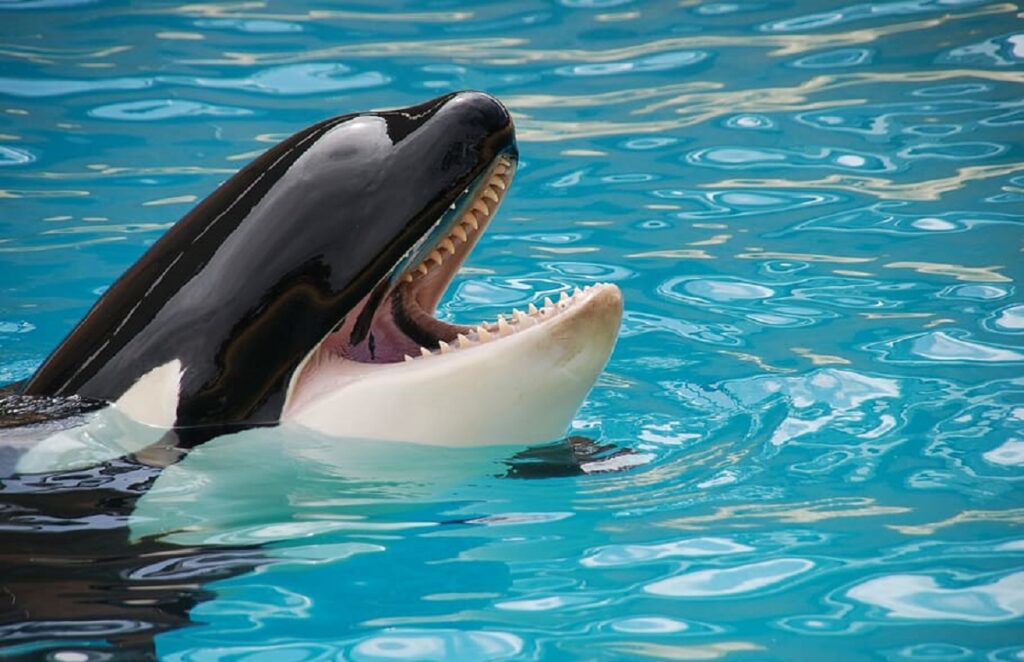
Orcas are formidable hunters. Equipped with conical, three-inch, interlocking teeth, they’re capable of tearing their prey into sizeable chunks. (source)
The Gestation Period of Orcas Is 17 Months (SeaWorld)
This long gestation period makes it crucial that humans protect this magnificent mammal and stop ocean pollution. An orca cow stays pregnant on average for 17 months in the wild and 15.7 to 18 months in captivity. (source)
Orcas Are Incredibly Swift Swimmers, Reaching Speeds of Up to 54 Kph (American Oceans)
Many fish and marine mammals are superb swimmers, while the fastest human reaches about 4 mph. Orcas, despite weighing six tons, reach speeds of 34 mph. (source)
Orcas Lack an Olfactory System, Suggesting They Lack a Sense of Smell (SeaWorld)
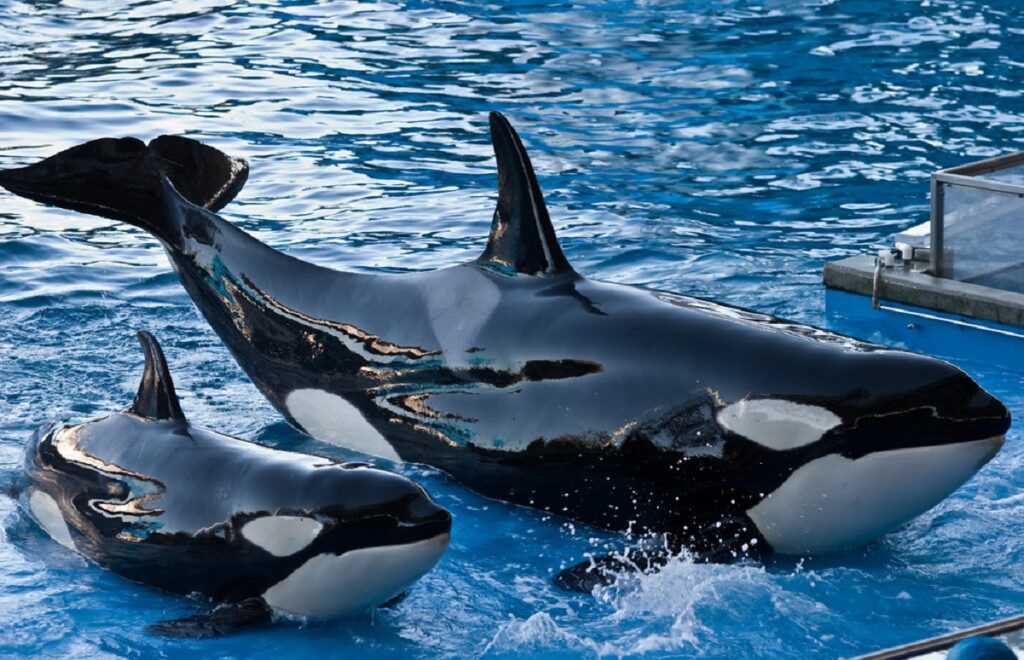
Toothed whales lack an olfactory lobe and don’t have a sense of smell. Since orcas spend most of their time underwater, they rely on echolocation to find prey. Using echos, they find shoals, seals, or other dolphins to hunt. (source)
Orcas Have the Second-Largest Brains in the Marine Mammal World, Weighing Up to 15 Pounds (Phy.org)
Marine biologists have identified that orcas sense and analyze their environment. Scientists search for tangible evidence that this ocean mammal has memory cells like humans. Sperm whales have the biggest brain that weighs up to 20 pounds. For comparison, a humpback whale’s brain weighs 14 lbs. (source)
The Lifespan of Orcas Is Around 50 – 90 Years (NOAA.gov)
Orcas definitely belong on the list of cool animals. They form tight connections with their family groups, and male orcas live for about 30 to 60 years, and females may live for 50 to 90 years. They reach sexual maturity at around 10 to 13. (source)
Orcas in captivity at SeaWorld spend up to 80% more time out of the water than in the wild.
Killer Whale Size
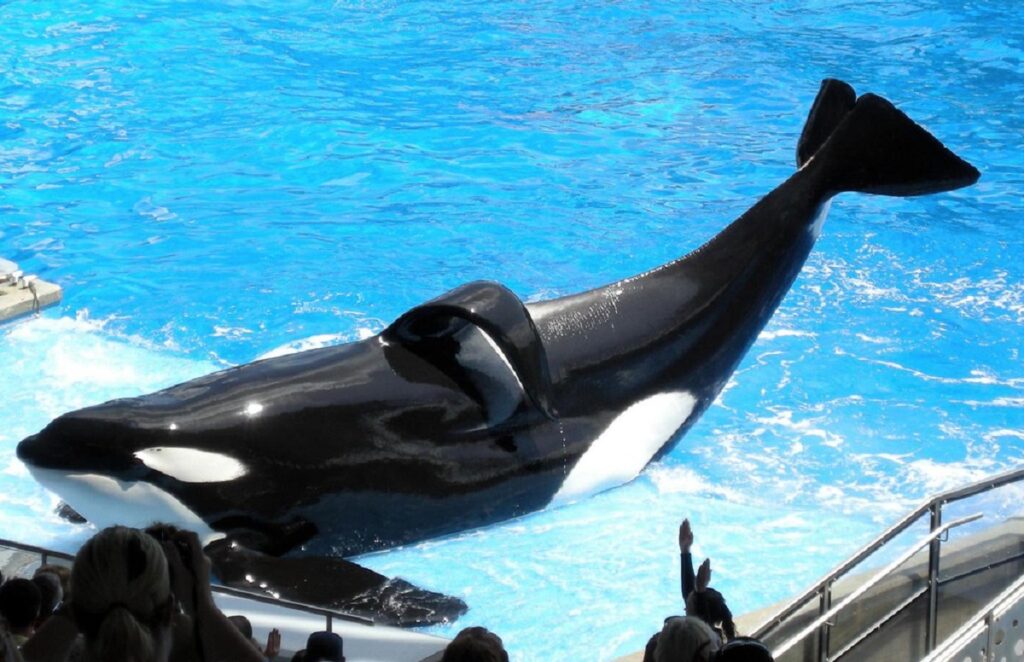
Blue whales are large whales measuring up to 100 feet, while North Atlantic right whales reach 45 to 60 feet and finbacks 72 to 80 feet, which makes orcas seem rather small.
The Length of Orcas Usually Falls Within 5.5 to 9.8 Meters (SeaWorld)
Orcinus orca is small compared to other whales, but they’re the largest dolphin group and can reach upward of 23 to 31 feet. Mature males are longer at 30 feet, and females average 25 feet.
Orcas Can Have a Maximum Weight of 5,500 Kilograms (SeaWorld)
A killer whale has between 8,000 and 16,000 pounds of body weight. Not sure how they project themselves 10 to 15 feet out of the water.
The Largest Orca Measured 32 Feet and Weighed 22,000lbs (SeaWorld)
Icelandic killer whale males reach 19 to 22 feet, while females measure 16 to 19 feet. They belong to the North Atlantic type 1 species, and orca sizes vary among ecotypes. Antarctic type C is the smallest type, measuring 18 ft for males and 17 ft for females.
SeaWorld killer whales average about 21.7ft for males and 18 ft for female orcas.
The Dorsal Fin of a Male Orca Can Reach Up to 1.8 Meters, Which Makes It the Largest Among All Cetaceans (SeaWorld)
Of all marine mammals, including whales, dolphins, or porpoises, the male orca has a dominating dorsal fin that makes it a very identifiable feature.
Males have a tall sail-like triangular fin that can be six feet tall, while females have a slight curve (falcate) to their three to four-foot fin.
Facts About Orcas
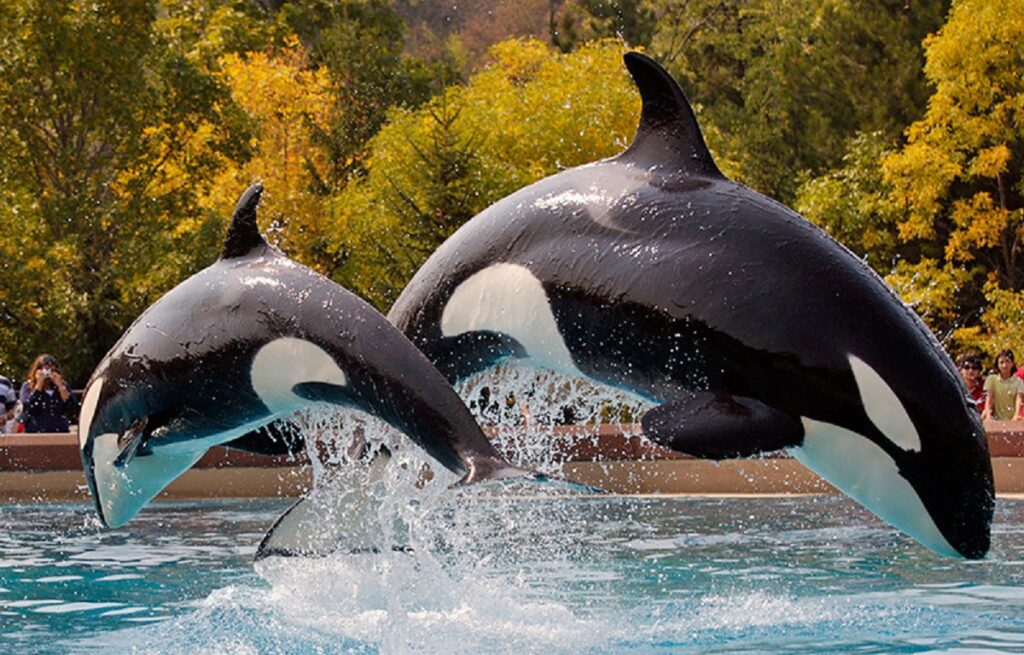
Let’s dive a little deeper into the depths of knowledge and explore fascinating facts about these majestic oceanic beings, the orcas.
Orcas Identify Their Prey via Echolocation (SeaWorld)
Killer whales don’t have a sense of smell and send out sound waves that reverberate back as an echo or echolocation and allow them to identify their prey.
Since communication is essential to orcas, perhaps they’ve not yet established a sound signal for ‘humans.’ Human attacks attributed to orcas, aside from the incidents at SeaWorld involving captive whales, are rare. (source)
Orcas Can Have a Non-Stop Traveling of Up to 9,400km (NCBI)
Scientists are researching these formidable swimmers. In one event, they tagged five Orcinus orcas off the coast of Uruguay and Brazil and found this group traveled great distances of 5075 nautical miles in 42 days. (source)
Orcas Communicate Through a Range of Distinct Languages (SeaWorld)
Marine biologists are discovering different dialects unique to each pod. For close-range communication, Orcinus orca whistle. These high-pitched whistle sounds are directional and don’t carry far underwater. o
Researchers found that northern resident killer whales whistle when traveling closely with others in the group and lessened them as they distanced from each other.
Transient Orcinus orcas use sparing whistle sounds and have a smaller whistle vocabulary than resident whales.
Orcas Prey Upon Fish, Seals, Seabirds, and Marine Turtles (Sea World)
Orcas have distinct dietary preferences for fish or marine mammals but not both. Their diet can include minke whales, elephant seals, sharks, rays, bony fish, dugongs, sea turtles, penguins, and seabirds, and up to 140 species. They might also eat their dolphin family playmates. (source)
Orcas Don’t Attack Humans (SeaWorld)
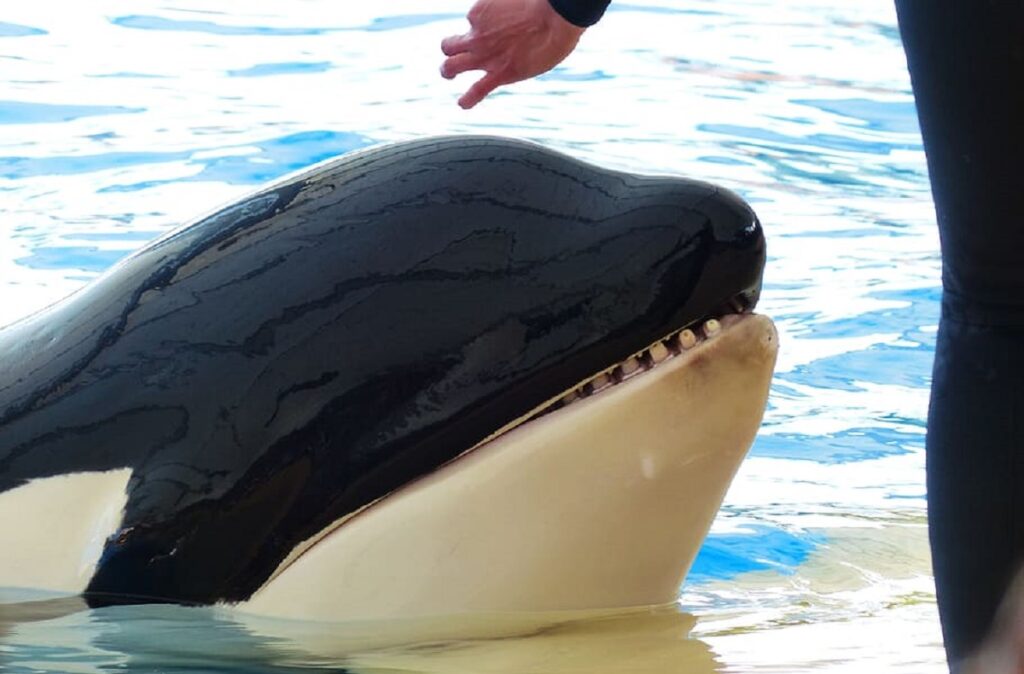
True, unless you’re talking about the trainers who were killed by Tilikum. Orca attacks on humans are rare, unlike shark attacks. Incidents of orcas ramming boat traffic happen.
Orcas Face Several Threats, Including Environmental Disruptions, Overfishing, Entanglement, and Contamination Risks (NOAA.gov)
If you’ve read our articles on ocean pollution, you understand that all marine animals are under threat. Killer whales belong to the Delphinidae family and are targeted by fishermen and commercial fishing gear. (source)
Today, orcas share the ocean with five gyres of plastic pollution, roughly 4 million fishing vessels, and thousands of container, cruise, and pleasure crafts.
Orcas Continue To Be Hunted in Certain Countries, Including Greenland (Au.dk)
Orcinus orcas are apex predators and are hunted in Japan, Norway, Greenland, and Iceland. Aside from being hunted, orcas suffer from contaminated human activities like ocean plastics (polychlorinated biphenyls). Scientists discovered 1300 milligrams per KG in their blubber. (source)
Overfishing is robbing all marine of food sources.
Orcas Have Been Listed As “Data Deficient,” According to IUCN (IUCN).
This status means there isn’t sufficient information on their numbers. Southern Resident Killer Whales (Coastline of Canada and the US) have an endangered status and are protected under the Endangered Species Act. (source)
In the US, Killer Whales Are Safeguarded by the Marine Mammal Protection Act (NOAA Fisheries)
The Marine Mammal Protection Act protects all Orcinus orca (supposedly). The Southern Resident Orcas Distinct Population (ESA) and AT1 Transient stock falls under MMPA.
While this looks great on paper, it’s not helping against marine pollution.
Killer Whale Facts
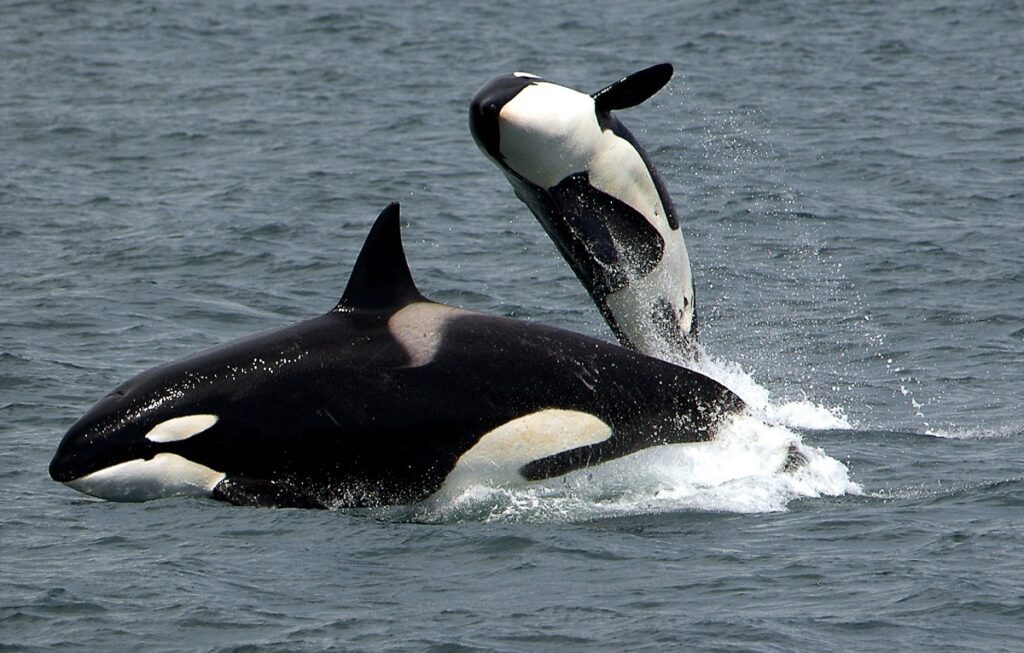
We’re learning more about killer whales; let’s hope it’s not too late to save them.
The Name “Killer Whale” Was Bestowed Upon Them by Ancient Sailors Who Observed Them Hunting Larger Whales (Whale and Dolphin Conservation)
Sometimes, words get lost in translation. Whale killer, translated from ballena asesina, was given to orcas Orcinus by ancient sailors who witnessed orcas on a hunt. Later, the name was reversed from Spanish to an English phrasing—killer whale. (source)
Orcas Showcase Remarkable Intelligence and Coordinated Hunting Abilities (American Oceans)
Marine biologists observed many killer whales and discovered their unique intelligence, including using tools, social learning, and adaptable and cooperative hunting. In essence, orcas learn and reason.
Studies reveal orcas experience self-awareness and recognize themselves in their reflection. They can problem solve, like creating waves to upend their prey.
Orcas Are Categorized Into “Ecotypes,” Specialized in Hunting Certain Prey and Residing in Distinct Regions (Whale and Dolphin Conservation)
Orcas are classified into three main types (10 recognized ecotypes) in the North Pacific. Resident, Transient, and Offshore. They vary in looks, diet, habitat, genetics, and behavior. (source)
At Present, There Are 10 Recognized Ecotypes of Orcas (Whale and Dolphin Conservation)
Southern resident killer whales live off the coast of Canada, Oregon, and Washington state. They’re the smallest group of southern resident orcas. Marine experts classify orcas into 10 diverse types:
- Resident orcinus orca
- North Atlantic Type 1
- North Atlantic Type 2
- Bigg’s killer whales
- Offshore
- Type A
- Type B Large
- Type B Small
- Type C
- Type D
Orcas Are the Sole Known Predators of Great White Sharks (Natural History Museum London)
Diverse groups of orcas hunt specific prey like bluefin tuna, elephant seals, and blue whales, while others hunt sharks. In 2011, researchers documented this behavior in the Pacific. (source)
Killer Whales Have Been Documented Hunting and Killing Swimming Deer and Moose (Primates and Cetaceans, Springer, 2014)
Primates and Cetaceans is a text that reveals studies on killer whale diets and ecological diversification. Divergent foraging from these generalist eaters may be part of the social isolation and genetics of killer whale populations, which in some locations may bring them into contact with swimming deer or moose.
South African Orcas Port and Starboard Were Witnessed Surgically Removing Sharks’ Liver With Great Precision (Phys.org)
Sharks washed ashore and discovered by passersby had distinct tear patterns from orca tooth imprints. These rake marks were prominent on the sharks’ distinct pectoral fins; scientists confirmed that the livers were missing. Sharks are formidable hunters too. (source)
Orca Predators
Killer whales dominate the food chain and only have one significant enemy: humans. Small victories like the East Russia Orca Project mean captured orcas are banned in oceanariums.
Fun Facts About Orcas
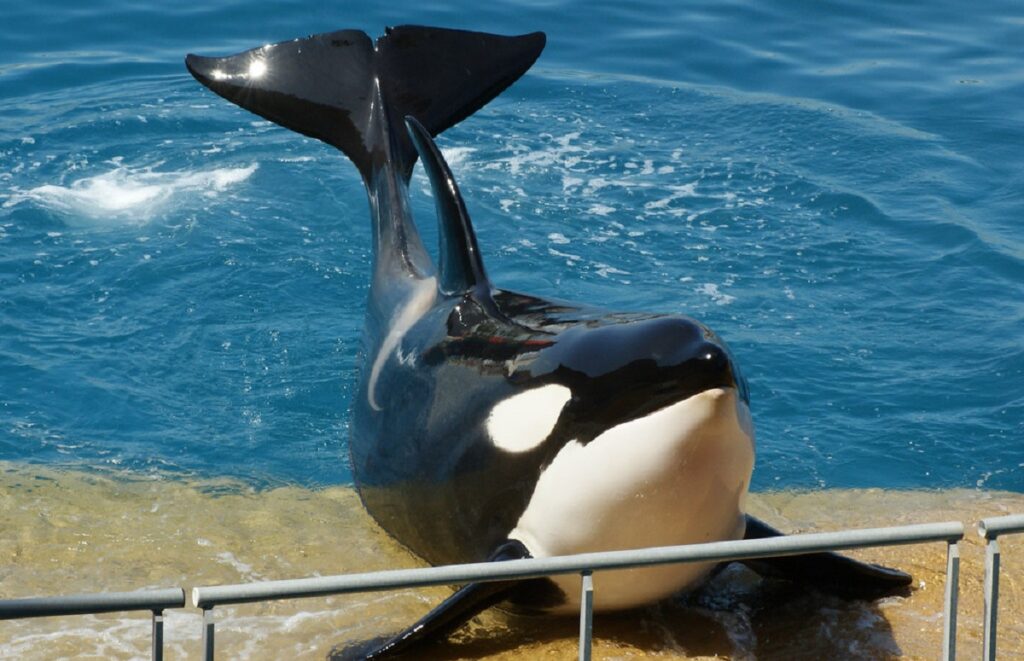
Orcas look like they’re perpetually smiling.
In the Wild, an Orca Pod Can Travel More Than 160 Kilometers Daily (Whale and Dolphin Conservation)
Fast and agile in and out of the water, killer whales cover a large distance while foraging and socializing.
Orcas Are Highly Social and Live in Family Pods, Which Can Include Up to 50 Members (University of Michigan, Animal Diversity Web)
Orca pods are made up of family members that remain with their descendants. These pods of up to 50 adult orcas and their offspring and known as matrilines. (source)
A Killer Whale Genetics Expert Discovered That Orcas and Humans Possess the Capacity for Culture-Based Evolution (Nature)
Killer whales and orcas develop a culture and pass on behavior and language. (source)
Orcas Are Among the Few Mammals That Experience Menopause (National Geographic)
Only humans and five-toothed whales survive past their reproductive years and experience menopause. (source)
Orcas Sleep While Keeping One Eye Open (Whale and Dolphin Conservation)
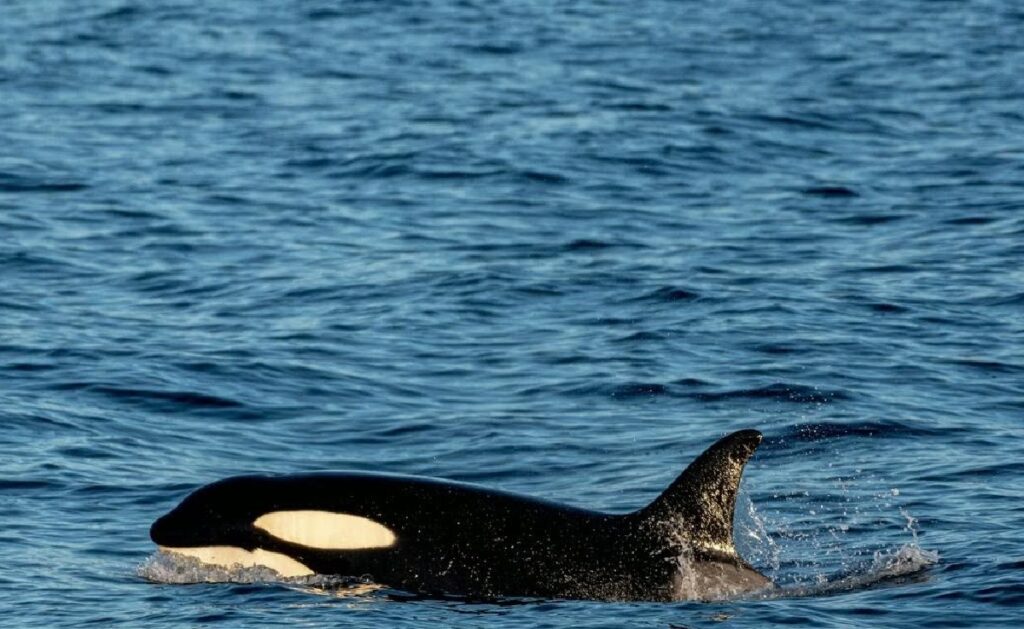
Orcas, the largest dolphin, can power down half of their brain and sleep with one eye open. This allows them to continue to breathe.
The 2013 Documentary “Blackfish” Centered on Tilikum, a SeaWorld Orca (Reuters)
Black Fish is a powerful documentary that details the complex relationship captive orcas develop with their trainers. Tilikum has killed and injured trainers, and the documentary explains his difficult journey in captivity. (source)
Captivating Facts about Orcas
- Orcas can reach 30 knots (34 mph).
- A small school bus measuring 19 to 26 feet is the same size as an adult orca. Orca weigh up to six tons.
- Orcas pass their knowledge and language on to their offspring, meaning they have culture. Each pod has a unique dialect and behavior traits.
- Estimates peg orca populations at 50,000. They exist in every ocean, from the frigid Arctic and Antarctic waters to the warm waters of the Arabian Sea and the Gulf of Mexico.
- Orcas sleep with one eye open. This unihemispheric sleep is unique to dolphins as they can power down half of their brain.
- Offshore orcas, considered an ecotype, live 15 km offshore in the northeast Pacific, and these apex predators eat great whites and whale sharks.
Orca Facts for Kids
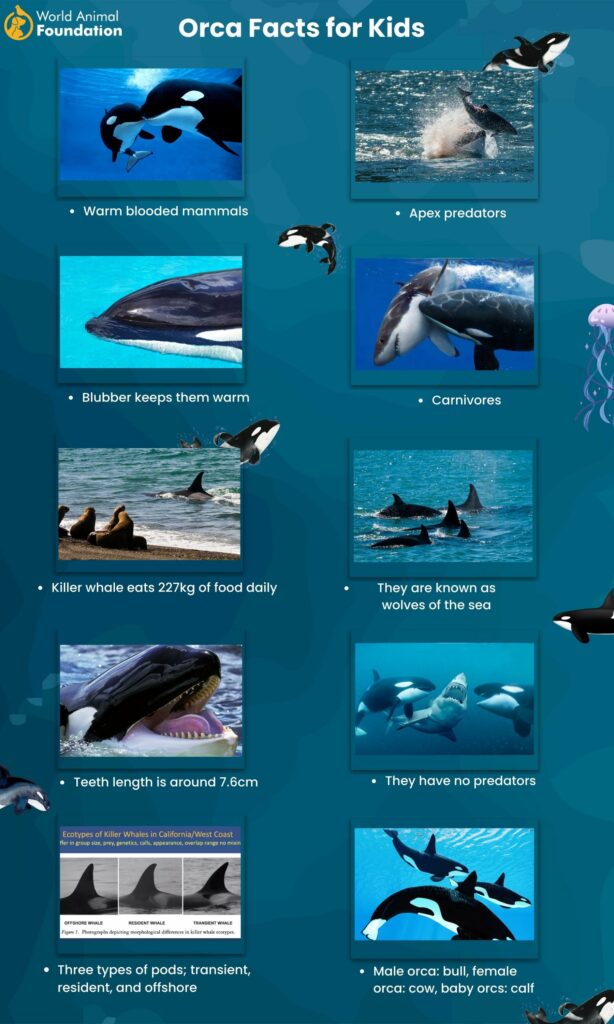
FAQs
Why Are Orcas Called Killer Whales?
Killer whale is a term that ancient sailors settled on this group of dolphins while they were hunting.
Are Orcas Dolphins?
Yes, orcas are the largest members of dolphins.
Are Orcas Whales or Dolphins?
Actually, dolphins are whales.
Do Orcas Eat Humans?
No. We’re not on their menu.
What Do Orcas Eat?
Different ecotypes consume different animals, like seals, turtles, sharks, other whales, and dolphins.
Has a Killer Whale Ever Killed a Human?
Yes, Tilikum has killed 3 people.
How Many People Have Been Killed by Orcas?
Four people died from captive orca attacks. No fatal attacks in the wild are recorded.
What Is a Group of Orcas Called?
A family group is called a pod.
How Big Do Orcas Get?
The largest orca, Old Tom, measured 32 feet and weighed 22,000 pounds.
How Much Do Orcas Weigh?
Killer whales weigh between 8,000 to 16,000 pounds.
What Does a Killer Whale Look Like?
Killer whales have a distinct black and white saddle pattern.
Are Orcas Mammals?
Orcas are marine mammals in the dolphin species.
How Do Orcas Sleep?
Orcas sleep with one eye open and power down half of their brain.
Orca Killer Whale: On the Brink of Extinction
Undoubtedly, orcas can be dangerous animals. It isn’t the first time people mislabeled and misunderstood one species—we’ve even continued to do it to ourselves.


